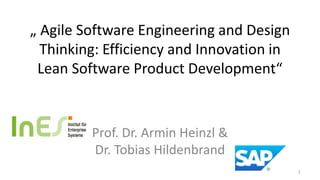
Agile Software Engineering and Design Thinking: Efficiency and Innovation in Lean Software Product Development
- 1. „ Agile Software Engineering and Design Thinking: Efficiency and Innovation in Lean Software Product Development“ Prof. Dr. Armin Heinzl & Dr. Tobias Hildenbrand 1
- 2. Agenda Introduction and Overview Lean and Agile Development Agile Software Engineering Techniques Design Thinking and Innovation Summary and Conclusion 2
- 3. Overview: Two Main Questions… (2) Where do innovative ideas and requirements come from? (1) How to build and deliver the software efficiently? 3
- 4. Why lean and agile development at SAP? 4
- 5. Development Process prior to Lean 5
- 6. Lean Product Development Flow How to efficiently deliver innovative enterprise software to customers? 6
- 7. Underlying Principles Source: Donald G. Reinertsen (2009) – Lean Product Development Flow 7
- 8. Why do Scrum teams adopt agile engineering techniques? 8
- 9. Agile Software Engineering Pair programming, test-driven development, continuous Specific agile techniques [6] ASE integration, refactoring Agile method Teams with Scrum master, product owner, developers as process framework [7] and an associated manager for people development Scrum Eliminate waste, build quality in, learn constantly, Lean principles [8] deliver fast, engage everyone, keep getting better Lean Principles 9
- 10. Adoption of ASE Techniques 10
- 11. Adoption Patterns for ASE • Minor variations for refactoring (REF) and continuous integration (CI) • Relatively low adoption rate for refactoring • Significant variations for pair programming and test driven development • Note: empirical inquiry represtens a snapshot- view 11
- 12. Where do the requirements come from and how does innovation happen? 12
- 13. An Analytic Approach Doesn‘t Work 13
- 14. Diverging and Converging in Iterations 14
- 15. Design Thinking A team-based, iterative approach to innovation 15
- 16. Three “Space of Innovation” 1. Human Desirability 2. Technical Feasibility Implementation 3. Economic Viability Based on: Tim Brown (2009): Change by Design 16
- 17. Innovation = Design & Development 2. Ideation 1. Inspiration 3. Implementation 17
- 18. How does innovation happen in practice? 18
- 19. Intertwining Lean and Design Thinking 19
- 20. Building People-Centric Software with Lean and Design Thinking 20
- 21. What are the three things to remember? 21
- 22. Summary and Conclusion (1) Design Thinking helps teams to find problems worth solving and create innovative solutions (2) Agile Software Engineering techniques help teams to build these solutions efficiently (3) Both approaches can complement the large- scale implementation of Lean significantly… 22
- 23. BACKUP MATERIAL 23
- 24. Study with 4 Development Teams 24
- 25. Evaluation of ASE Techniques 25
- 26. Agile Software Engineering (ASE) 26
